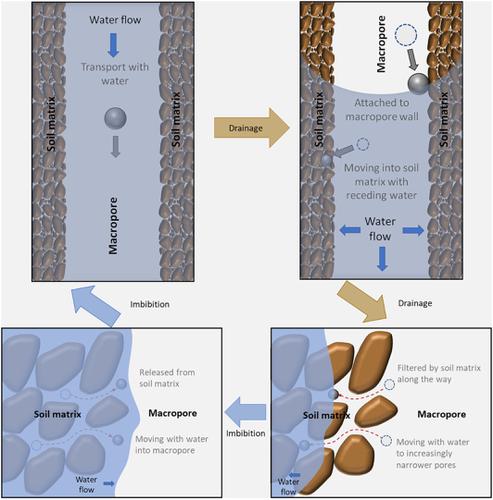当前位置:
X-MOL 学术
›
WIREs Water
›
论文详情
Our official English website, www.x-mol.net, welcomes your
feedback! (Note: you will need to create a separate account there.)
Colloid transport through soil and other porous media under transient flow conditions—A review
WIREs Water ( IF 6.8 ) Pub Date : 2020-04-26 , DOI: 10.1002/wat2.1439 Chaozi Wang 1, 2 , Ruoyu Wang 2 , Zailin Huo 1 , En Xie 1 , Helen E. Dahlke 2
WIREs Water ( IF 6.8 ) Pub Date : 2020-04-26 , DOI: 10.1002/wat2.1439 Chaozi Wang 1, 2 , Ruoyu Wang 2 , Zailin Huo 1 , En Xie 1 , Helen E. Dahlke 2
Affiliation

|
Understanding colloid transport in porous media under transient‐flow conditions is crucial in understanding contaminant transport in soil or the vadose zone where flow conditions vary constantly. In this article, we provide a review of experimental studies, numerical approaches, and new technologies available to determine the transport of colloids in transient flow. Experiments indicate that soil structure and preferential flow are primary factors. In undisturbed soils with preferential flow pathways, macropores serve as main conduits for colloid transport. In homogeneously packed soil, the soil matrix often serves as filter. At the macroscale, transient flow facilitates colloid transport by frequently disturbing the force balance that retains colloids in the soil as indicated by the offset between colloid breakthrough peaks and discharge peaks. At the pore‐scale and under saturated condition, straining, and attachment at solid–water interfaces are the main mechanisms for colloid retention. Variably saturated conditions add more complexity, such as immobile water zones, film straining, attachment to air–water interfaces, and air–water–solid contact lines. Filter ripening, size exclusion, ionic strength, and hydrophobicity are identified as the most influential factors. Our review indicates that microscale and continuum‐scale models for colloid transport under transient‐flow conditions are rare, compared to the numerous steady‐state models. The few transient flow models that do exist are highly parameterized and suffer from a lack of a priori information of required pore‐scale parameters. However, new techniques are becoming available to measure colloid transport in real‐time and in a nondestructive way that might help to better understand transient flow colloid transport.
中文翻译:

在瞬态流动条件下通过土壤和其他多孔介质的胶体运输—综述
了解瞬态流动条件下多孔介质中胶体的迁移对于理解土壤或渗流条件下流体条件不断变化的污染物传输至关重要。在本文中,我们对实验研究,数值方法和可用于确定瞬时流动中胶体运输的新技术进行了综述。实验表明,土壤结构和优先流动是主要因素。在具有优先流动路径的原状土壤中,大孔充当胶体运输的主要管道。在均匀填充的土壤中,土壤基质经常充当过滤器。在宏观上,瞬态流动通过经常破坏力平衡来促进胶体运输,力平衡使胶体保留在土壤中,如胶体穿透峰和排放峰之间的偏移所表明的。在孔尺度和饱和条件下,固液界面处的应变和附着是胶体保留的主要机制。不断变化的饱和条件会增加更多的复杂性,例如不动的水区域,薄膜张紧,附着在空气-水界面以及空气-水-固体接触线上。过滤器成熟度,尺寸排阻,离子强度和疏水性被认为是最有影响力的因素。我们的评论表明,与众多稳态模型相比,瞬态流动条件下胶体运输的微观和连续尺度模型很少见。确实存在的几个瞬态流动模型是高度参数化的,并且缺少所需的孔尺度参数的先验信息。然而,
更新日期:2020-04-26
中文翻译:

在瞬态流动条件下通过土壤和其他多孔介质的胶体运输—综述
了解瞬态流动条件下多孔介质中胶体的迁移对于理解土壤或渗流条件下流体条件不断变化的污染物传输至关重要。在本文中,我们对实验研究,数值方法和可用于确定瞬时流动中胶体运输的新技术进行了综述。实验表明,土壤结构和优先流动是主要因素。在具有优先流动路径的原状土壤中,大孔充当胶体运输的主要管道。在均匀填充的土壤中,土壤基质经常充当过滤器。在宏观上,瞬态流动通过经常破坏力平衡来促进胶体运输,力平衡使胶体保留在土壤中,如胶体穿透峰和排放峰之间的偏移所表明的。在孔尺度和饱和条件下,固液界面处的应变和附着是胶体保留的主要机制。不断变化的饱和条件会增加更多的复杂性,例如不动的水区域,薄膜张紧,附着在空气-水界面以及空气-水-固体接触线上。过滤器成熟度,尺寸排阻,离子强度和疏水性被认为是最有影响力的因素。我们的评论表明,与众多稳态模型相比,瞬态流动条件下胶体运输的微观和连续尺度模型很少见。确实存在的几个瞬态流动模型是高度参数化的,并且缺少所需的孔尺度参数的先验信息。然而,











































 京公网安备 11010802027423号
京公网安备 11010802027423号